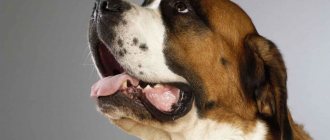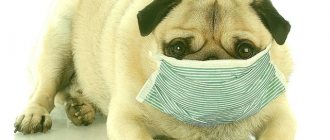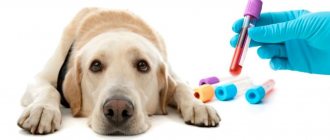Gray diarrhea in a dog: Causes
Typically, the color of stool depends on the presence of processed bile in it, primarily the pigment stercobilin. Also, the color can change due to impurities, for example, if there is bleeding in the stomach or small intestine, the stool will turn black - this is the so-called melena. Discoloration to gray may be due to impaired flow of bile into the duodenum.
This can happen for a number of reasons:
- Stricture or blockage of the biliary tract. Narrowing can occur due to inflammation, and obstruction can be caused by stones, clots, or neoplasms.
- Hepatitis.
- Cholecystitis.
- Pancreatitis.
- Tumor lesions of the liver, gall bladder, pancreas.
In addition to disruption of bile flow, there may be other reasons:
- Eating large amounts of monotonous food, especially fatty foods.
- Taking certain medications. For example, drinking barium sulfate to diagnose diseases of the digestive system.
- Changes in the quantitative and qualitative composition of the intestinal microflora.
Therapeutic diet and drinking regime
If your pet has diarrhea, the first step is to put him on a 12-24 hour fasting diet. Representatives of dwarf breeds, as well as newborn puppies, should not be fed for more than 6-10 hours. In this case, the pet must have constant access to fresh drinking filtered water.
If the animal refuses to drink on its own, pour water into the mouth in small portions through a regular syringe without a needle. Water can be replaced with tea or herbal infusions with the approval of a veterinarian - you will receive an initial consultation by phone. It may be easier for your dog to lick an ice cube - this is a good solution if he is vomiting.
“ Please note that giving a puppy solid food when it has diarrhea is strictly prohibited. Especially if there is mucus in the excrement. Eating food can trigger vomiting and will only make the situation worse.
Fasting relieves inflammation in the intestines and gastrointestinal tract, and also stops minor internal bleeding. To normalize the electrolyte balance and replenish fluid loss in the body, give the puppy Regidron solution.
In severe advanced cases, infusion therapy is carried out in a veterinary clinic. Physiological solutions (isotonic glucose, Ringer-Locke solution) are administered intravenously to puppies.
Every dog owner should know what to feed his puppy when he has diarrhea - this will come in handy at least once in his life. Symptoms of diarrhea are quickly relieved by steep rice decoction, decoction of oak bark, chamomile, St. John's wort, sage, and yarrow. These simple and affordable remedies have an astringent and anti-inflammatory effect. Before use, consult a veterinarian.
“ At the first signs of improvement, you can give the puppy boiled chicken or turkey meat, veal, or lean broth. An alternative is dietary wet food.
Gradually introduce fermented milk products into your diet - low-fat cottage cheese, natural yogurt, kefir. Fermented milk nutrition has a beneficial effect on the gastrointestinal tract and normalizes the intestinal flora. For porridges, it is best to give buckwheat, rice, oatmeal, cooked in water or meat broth. Introduce new foods into your diet gradually, in small portions.
Food must be crushed for at least the first 3-4 days to make it easier for the intestines to digest it. The daily portion is divided into many small parts and served warm to the puppy more often than usual. If the dog refuses to eat, there is no need to force him - but you will definitely have to give him water.
Dry food is excluded from the diet for a while, replacing it with natural food or wet diet food. All dishes must be fresh and of high quality.
Diagnostics
If you notice gray stool in your pet and there is no simple explanation for its occurrence, we recommend that you consult a doctor immediately. Already during the examination, a specialist can suggest a diagnosis. For example, if a dog has icteric mucous membranes, this may indicate obstructive jaundice, combined with gray stools.
Research that you will be asked to conduct:
- Biochemical and general clinical blood test. Based on the changes, it will be possible to guess, or say with accuracy, what the problem is related to.
- Ultrasound examination of the abdominal cavity. It will show whether there are structural changes in organs, the presence of stones, tumors.
- If necessary, additional diagnostics are carried out in the form of MRI and others.
It is worth noting that coprogram is not an informative research method. It is advisable to take a stool test only to detect hidden blood, parasites, and infections.
Watch the video: Diarrhea in a dog - How to help? The vet tells
What is the normal color of dog poop?
Dog stool has 4 main parameters to evaluate: color, consistency, coverage and content. The normal color of feces in a healthy dog is chocolate brown, without any mucous coating or inclusions of other colors. The surface of the “sausage” should always remain flat so that individual fluff or solid particles do not stick out from it. A change in color to green, yellow, reddish, dark gray or even black indicates a problem in the dog’s body, so the owner should take a closer look at other possible symptoms of trouble.
Did you know? The fattest dog in the Guinness Book of Records is a border collie named Cassie. While the norm for her breed was 20 kg, she weighed 58 kg, which had a negative impact on her health.
The dog has gray diarrhea: Treatment
At home, you can add veterinary probiotics to your dog’s diet: Vetom, Bifitrilak, Lactobifadol, Forti Flora, Prokolin .
Normalize the diet if there are any errors.
To fix the stool, you can give Enterosgel, Smecta, Polysorb or Activated carbon .
However, these manipulations can only remove the symptom, and it is necessary to find out the cause, since it can be quite serious.
The veterinarian will prescribe a diet for the dog. Hill's l/d, Royal Canin or Monge Hepatic food .
For pancreatitis Hills or Royal Canin Low Fet .
If the problem is related to the intestinal microflora, then a gastrointestinal diet of the same brands will be recommended.
In case of decreased appetite, its absence or severe general condition, Hills a/d, Proplan C/N, Royal Canin or Monge Recovery .
For liver inflammation, hepatoprotectors are prescribed: Milk thistle, Ursodeoxycholic acid, Heptral . If there is inflammation of the gallbladder or sludge in it, then the doctor may additionally recommend donating bile for culture and cytological examination. This is necessary in order to understand whether the pathological process is sterile and whether antimicrobial therapy is needed.
To treat pancreatitis, painkillers and, if necessary, an antibiotic are added.
If there is cholelithiasis or the need to remove stones or the gallbladder, surgical treatment is performed, including minimally invasive endoscopic treatment.
We talked about standard treatment regimens, but they may vary depending on the general condition, concomitant diseases, and research results.
Specialized dog food
Indications for the procedure
Heartburn as a symptom of Helicobacter disease.
Despite the fact that Helicobacter pylori often parasitizes the human body, its presence does not always lead to pathological disorders.
A large number of people do not experience symptoms when this bacterium appears. If certain symptoms appear, a person should consult a gastroenterologist, who, after a preliminary examination, will prescribe appropriate treatment.
The dog has gray diarrhea. Are there veterinary gastroenterologists in Moscow?
List of veterinary clinics in Moscow that provide highly qualified care.
- Medvet clinic network . Branch ave. Vernadsky, 89, bldg. 6. Veterinary conferences and internships for specialists are held at the clinic. An appointment with a therapist costs about 1,300 rubles.
- White Fang Veterinary Network . They work around the clock. There is a doctor's call at home. An appointment with a therapist costs about 1,500 rubles, one of the gastroenterologists is D.A. Zheltysheva. – 2800 rubles.
- Zoostatus . Varshavskoe highway, 125, building 1. Works around the clock. An appointment with a therapist costs about 1,500 rubles. Examination by a gastroenterologist 2000 rubles.
- Biocontrol . Kashirskoye sh., 24, building 10. Appointment with a therapist: 1,500 rubles. The clinic provides a pet taxi service, and it is also possible to hold a consultation of three veterinarians.
- Network of clinics Your doctor . Appointment with a general specialist costs 900 rubles, and a specialized specialist costs about 1,500 rubles.
- Vega veterinary clinic network . Marshal Katukov str. 17 building 1. The branch opened in March 2022.
Read other articles about diarrhea in dogs - from small to large: Diarrhea in an old dog: Causes. Treatment. How to help at home? – Bloody diarrhea in a dog: How to help a dog, how to treat it – Bloody diarrhea with vomiting in a puppy: Causes, treatment methods –
Prevention of the condition
To prevent this condition of the animal, you should:
- give up fatty foods;
- monitor the dog’s hygiene;
- regularly add vitamins and microelements to the feed;
- monitor your pet's health.
The right approach to diet will help avoid diarrhea and changes in stool color.
Knowing why a dog may have yellow stool and what diseases such a symptom is a harbinger of, the owner will be able to provide timely help to the pet. It is enough to fulfill a number of conditions: reduce the amount of fatty foods, undergo regular examinations and examinations by a veterinarian and maintain hygiene.
Gray diarrhea in a dog. Rostov-on-Don, choice of clinic.
- Veterinary clinic Zoodrug . Khalturinsky Lane, 156. An initial appointment with a therapist costs 300 rubles, and a gastroenterologist 500 rubles.
- Center for Veterinary Medicine . St. Belorusskaya, 203a. Around the clock. Initial appointment 260 rubles. There is a doctor call service.
- Veterinary clinic Amigo . St. Metallurgicheskaya, 36/19, floor 1. Around the clock. Initial appointment 350 rubles.
- Vet service . St. 18 line, 76. Examination by a therapist 350 rubles.
- Clinic of veterinary care of Dr. Zubkov . St. Profsoyuznaya 47. The clinic has a hospital service.
- Doctor Cat . St. Lermontovskaya 161. Call service, a call costs 500 rubles.
- Veterinary complex Umka . St. Lenina, 42. Calling a doctor to your home costs 300 rubles. Examination and consultation - 250 rubles.
Users of the Zoon website note the high professionalism of the Zoodrug clinic specialists. The administrators and chief physician of the Doctorkot and Amigo clinics also received positive comments.
Symptoms of breast cancer
The human mammary glands are composed of three types of tissue - connective, adipose and glandular. Breast cancer is a malignant tumor that develops in glandular tissue. There is a myth that this disease affects only the female part of the population, but this is not true; there are men with this diagnosis. However, in women this type of cancer is 100 times more common. Mutations leading to the development of oncology can be hereditary or acquired.
Like many other malignant tumors, breast cancer develops asymptomatically. Often, the disease is discovered by patients themselves or discovered by chance during preventive studies. Experts identify a number of symptoms of breast cancer:
- The appearance of a palpable formation, discharge from the nipple;
- The presence of asymmetry due to changes in the size of the affected gland;
- Wrinkling of the chest;
- Flattening of the skin over the tumor;
- Appearance of “lemon peel”;
- Forga's symptom – on the affected side the nipple is higher than on the healthy breast;
- Krause's sign - the nipple is thickened, the folds of the areola are noticeably pronounced;
- Redness;
- Bloody or purulent discharge;
- Edema.
Where to go in St. Petersburg?
- Network of veterinary clinics Kotonai . Per. Alpiysky, 29. Chief physician, gastroenterologist Degtyareva Yu.Yu. Appointment with a therapist is 700 rubles, a specialist is 1200.
- Vega veterinary clinic network . Branch st. Pulkovskaya 11 building 1. The appointment is conducted by gastroenterologist E.A. Gaidarenko. Appointment with a therapist costs 500 rubles.
- Network of veterinary clinics Cityvet . Exists for more than 10 years. More than 1000 positive reviews. There are often promotions and discounts on services. Reception 650 rubles, specialist - 1000 rubles.
- Veterinary Clinic named after. Ivan Fillmore . Etc. Engelsa, 154. Appointment with a therapist: 1,500 rubles. There is a department for working with homeless animals.
- Network of veterinary clinics of Dr. Sotnikov . Over 13 years of work, more than 150,000 happy patients. Initial appointment with a therapist is 1200 rubles.
The reviews noted the convenience of a separate infectious diseases hospital in the clinic named after. Ivan Fillmore and the presence of a CT scan. Dr. Sotnikov’s clinic has its own modern veterinary laboratory “Poisk”, the results are ready quite quickly. In the Vega and Kotonai clinics there is a gastroenterologist who can perform an ultrasound immediately at the appointment.
Quantity
Skin Cancer Symptoms
Skin cancer is a malignant neoplasm that poses a serious threat to health. Every year the number of patients with this diagnosis is growing steadily. The main symptom of this malignant tumor is the appearance of a neoplasm in the form of a small compaction, colored dark brown, red or even black, although the color of the tumor may not differ much from the color of healthy skin.
Doctors identify the following main symptoms:
- Bleeding and ulceration;
- Change in skin color;
- Pain in the area of the formation, which may intensify with pressure;
- Burning and itching;
- Soreness and enlargement of the lymph nodes near the tumor;
- Thickening of the skin area.
Symptoms
Since diarrhea is only a symptom of the disease, you need to pay attention to other manifestations of the pathology: vomiting (very often) - sometimes very persistent and frequent, nausea (before vomiting, with nausea, there may be restlessness, whining, increased salivation); weakness; lack of appetite; abdominal pain; chills, elevated body temperature (normal temperature in Yorkies and other small dogs is 37.7-39.0 °C). Diarrhea will look different for different illnesses. The difference may be in color, consistency, smell, mucus and undigested food particles. Signs accompanying diarrhea provide partial information about the disease that caused it.
Green loose stool
Characteristic of infectious diseases and dysbacteriosis. It also often happens with chronic poisoning, allergies and chronic gastrointestinal diseases. Sometimes it can occur with uncomplicated digestive disorders, for example, when eating low-quality food.
White diarrhea
It is noted in diseases of the pancreas and liver. The whiteness of feces is due to the fact that the gastrointestinal tract is not able to fully or partially process the fats that enter it with food. Sometimes white diarrhea occurs when eating something inedible (perversion of appetite) or toxic (spoiled feed, food). Watery, white-greenish diarrhea can occur with giardiasis. In puppies, white diarrhea is possible with enterotropic viral infections that are not strictly “canine”. With such diseases, dogs do not have specific symptoms.
Black diarrhea
The most harmless causes of blackening of feces are the consumption of activated carbon the day before or any food that can turn feces black, such as some offal. Less commonly, black diarrhea can occur after prolonged constipation. For example, when a dog ate something inedible. Usually this condition is accompanied by intoxication, which can lead to negative consequences. Therefore, it is better to contact veterinary specialists. The most severe case of black diarrhea is called melena. The stool looks like thick tar, sometimes with clots of coagulated blood. The color and consistency of stool with melena is due to the presence of serious gastrointestinal bleeding. Most often, lesions are localized in the small intestine, closer to the stomach. With such a pathology, veterinary care is necessary, most often this is surgical intervention. Also, black diarrhea is possible with intense parasitic infestation - when there are too many worms and they injure the intestinal mucosa. Another reason for black diarrhea in dogs is the presence of neoplasms (benign/malignant) in the gastrointestinal tract.
Yellow liquid stool
Yellow diarrhea indicates digestive disorders caused by a wide variety of reasons: stale, fatty foods; cheap, poor quality dry food; helminthic infestation; allergic reaction; enterotropic viral/bacterial infections; dysbacteriosis; use of vaccines, antibiotics, anthelmintics; congenital/acquired diseases of the liver, gall bladder and its ducts. Any of the listed reasons can cause yellow diarrhea, but most often these are diseases of the liver and gall bladder (+ factors that cause them), and enterotropic infections.
Bloody diarrhea
Most often, bloody diarrhea is a symptom of parvovirus enteritis. This disease is dangerous for any dog, but for small breeds it is more often fatal. The distinctive feature of parvovirus bloody diarrhea is the combination of color, consistency and odor. The color of feces in this disease is not blood-red, but more reminiscent of the color of meat slop, the consistency is watery, with a lot of mucus and an extremely fetid, persistent smell of rotten meat. In addition to parvovirus enteritis, bloody diarrhea can occur with salmonellosis, hemorrhagic leptospirosis, and even with an atypical form of rabies. Also, the causes of diarrhea with blood in Yorkies can be foreign objects in the lumen of the gastrointestinal tract, injuring the mucous membranes and walls of the intestines or stomach. This category of causes also includes helminthic infestation. In addition to injury to the wall of the gastrointestinal tract by parasites, intoxication caused by the metabolic products of worms is added. A Yorkie can have bloody diarrhea due to severe poisoning with chemicals, a severe allergic reaction, and the formation of various neoplasms in the gastrointestinal tract.
Stool with mucus
Mucus is always present in small quantities in feces. It is produced by the mucous membrane and protects the walls of the gastrointestinal tract from drying out and injury. But during inflammatory processes, mucus is produced many times more. This is necessary so that the body can quickly and painlessly get rid of the cause of inflammation and its consequences. Increased secretion of mucus in the gastrointestinal tract is observed: with colitis (inflammation of the large intestine); dysbacteriosis (including dysbiosis in a puppy when changing the type of food); helminthiasis; blockage by a foreign body; intussusception (invasion of one part of the intestine into another); various neoplasms in the gastrointestinal tract; constipation
Diarrhea and vomiting
With any disease affecting the digestive system, symptoms include diarrhea and vomiting. This is a protective reaction aimed at evacuating pathogens and toxins from the body that lead to illness. But debilitating vomiting and persistent diarrhea can deplete the body in a short period and lead to irreversible consequences. This is especially important for small dogs - with a small body weight, dehydration will occur very quickly. If the dog is lethargic, does not drink or eat, vomits frequently (more than 2 times a day), or has persistent, profuse diarrhea, then you should definitely take it to the veterinarian. The faster this is done, the greater the chance of recovery.
Chronic diarrhea
Chronic diarrhea is diarrhea that does not stop for more than 3 weeks. During this period, the disease can “subside” and return again (alternating periods of exacerbation and remission). The causes of chronic diarrhea can be in one part of the intestine or in all parts of the digestive tract, including the stomach. These include enterocolitis and gastroenterocolitis. Chronic diarrhea can also affect the endocrine system, disrupting the water and electrolyte balance. Chronic diarrhea develops in 4 types: Increased secretion of fluid in the intestines. Reduced absorption of fluid in the intestines. High permeability of the intestinal walls. Strong intestinal peristalsis. The causes of chronic diarrhea can be: permanent disturbances in feeding (poor quality of food, unbalanced diet, overfeeding); secretory pancreatic insufficiency; primary diseases of the small and/or large intestine (non-contagious inflammation, enteropathy, tumors, infections, invasions, incomplete obstruction (blockage) of the intestinal lumen, dysbacteriosis, “short bowel” syndrome); allergy. In addition to discomfort and impaired digestion, chronic diarrhea greatly affects the immune system. After all, the intestine is the most important lymphoid organ, necessary to provide the body with nonspecific resistance (the ability to resist various unfavorable factors).











